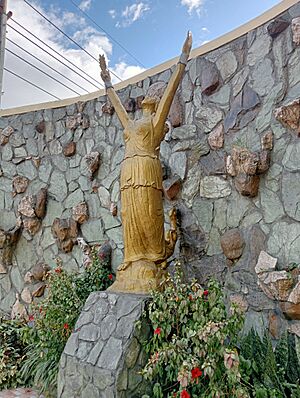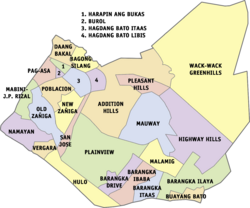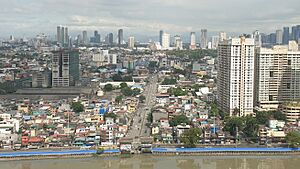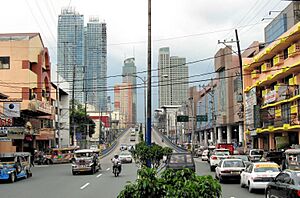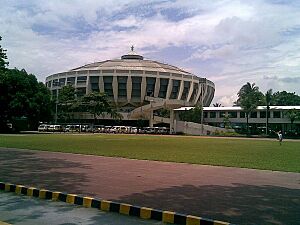Mandaluyong facts for kids
Quick facts for kids
Mandaluyong
|
|||
|---|---|---|---|
|
Highly urbanized city
|
|||
|
Aerial view of Mandaluyong
Shaw Boulevard
Mandaluyong City Hall
San Felipe Neri Parish Church
National Center for Mental Health
Correctional Institution for Women
SM Megamall
Welcome Sign
Wack Wack Golf and Country Club
|
|||
|
|||
| Nickname(s):
Tiger City of the Philippines Shopping Capital of the Philippines
|
|||
| Motto(s):
Gawa, hindi salita!
English: "Action, not words!" |
|||
| Anthem: Martsa ng Mandaluyong English: Mandaluyong March |
|||
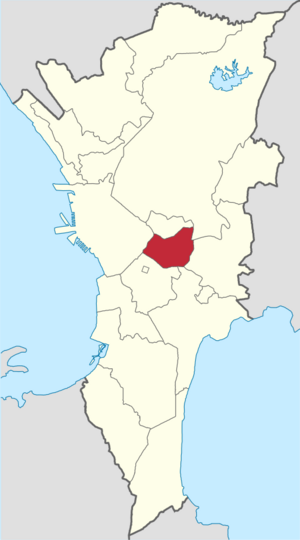
Map of Metro Manila with Mandaluyong highlighted
|
|||
|
OpenStreetMap
|
|||
| Country | |||
| Region | National Capital Region | ||
| District | [[{{#property:P7938}} | — Lua error in Module:Wd at line 1804: attempt to index field 'wikibase' (a nil value).]] | ||
| Founded | 1841 | ||
| Chartered | March 27, 1907 | ||
| Renamed | November 6, 1931 (as Mandaluyong) | ||
| Cityhood and HUC | February 9, 1994 | ||
| Barangays | 27 (see Barangays) | ||
| Government
|
|||
| • Type | Sangguniang Panlungsod | ||
| Area | |||
| • Total | 11.26 km2 (4.35 sq mi) | ||
| Elevation | 32 m (105 ft) | ||
| Highest elevation | 592 m (1,942 ft) | ||
| Lowest elevation | -2 m (−6.6 ft) | ||
| Population
(2020 census)
|
|||
| • Total | 425,758 | ||
| • Density | 37,812/km2 (97,930/sq mi) | ||
| • Households | 116,954 | ||
| Demonym(s) | Mandaleño | ||
| Economy | |||
| • Income class | 1st city income class | ||
| • Poverty incidence |
|
||
| • Revenue | ₱ 5,560 million (2020) | ||
| • Assets | ₱ 6,916 million (2020) | ||
| • Expenditure | ₱ 5,009 million (2020) | ||
| Service provider | |||
| • Electricity | Manila Electric Company (Meralco) | ||
| Time zone | UTC+8 (PST) | ||
| PSGC |
[https://psa.gov.ph/classification/psgc/?q=psgc/barangays/{{#pro000®code={{&provcode=
|
||
| IDD : area code | +63 (0)02 | ||
| Native languages | Tagalog | ||
| Major religions | Roman Catholic | ||
| Feast date | May 26 | ||
| Catholic diocese | Roman Catholic Archdiocese of Manila | ||
| Patron saint | Saint Philip Neri Immaculate Conception | ||
| Website | mandaluyong |
||
Mandaluyong (![]() i/məndɑːˈlujɒŋ/ MƏN-dah-LOO-yong; Tagalog pronunciation: [mɐndɐˈlujoŋ]), officially the City of Mandaluyong (Filipino: Lungsod ng Mandaluyong, [luŋˈsod nɐŋ mɐndɐˈlujoŋ]), is a highly urbanized city in the National Capital Region of the Philippines. According to the 2020 census, it has a population of 425,758 people.
i/məndɑːˈlujɒŋ/ MƏN-dah-LOO-yong; Tagalog pronunciation: [mɐndɐˈlujoŋ]), officially the City of Mandaluyong (Filipino: Lungsod ng Mandaluyong, [luŋˈsod nɐŋ mɐndɐˈlujoŋ]), is a highly urbanized city in the National Capital Region of the Philippines. According to the 2020 census, it has a population of 425,758 people.
Located directly east of Manila, Mandaluyong was originally a barrio of Santa Ana de Sapa (now a district of Manila) called San Felipe Neri. It separated and became its own town in 1841, and later acquired the name Mandaluyong in 1931 during the American occupation. In 1994, it became the first municipality of Metro Manila to become a city since the metropolis' establishment in 1975.
At present, it is known for the Ortigas Center, a commercial and business center that it also shares with the city of Pasig. Notable institutions and establishments in the city include the Asian Development Bank, the headquarters of Banco de Oro and San Miguel Corporation and shopping malls like Shangri-La Plaza and SM Megamall.
The city is bordered by Manila to the west, San Juan to the north, Quezon City to the northeast, Pasig to the east, Taguig to the southeast, and Makati to the south. It is also the 6th-smallest city in the Philippines with a land area of 21.26 km2 (8.21 sq mi), similar to Makati and Marikina.
Contents
Etymology
There are different stories on the origin of the name Mandaluyong.
One tells of how the place was abundant with a kind of tree called luyong, now more commonly known as anahaw (Saribus rotundifolius), from which canes and furniture were made.
Another claims that the Spaniards named the place based on the report of a navigator named Acapulco, who saw the rolling hills frequently being lashed at by daluyong (“big waves from the sea”). This seems to confirm traditional pre-Hispanic stories that giant waves from the sea would meet the adjoining hills of the vast lowland, referred to as salpukan ng alon. Felix dela Huerta, a Franciscan historian, observed that the rolling topography of this land resembled giant waves of the sea.
As with the etymological legends of many Philippine places, when the foreigners asked what the place was called, the locals answered with the description "madaluyong" ("undulating"), later transcribed by Spanish writers as "Mandaluyong," with the addition of an “n”.
Another version of the name is based on a legend that a Maharlika named Luyong fell in love with Manda, the lovely daughter of a barangay chieftain. The chieftain did not like Luyong and forbade him Manda's hand. Luyong overcame this objection by winning a series of tribal contests, as was the custom at the time. The couple settled thereafter in a place which was later called “Mandaluyong" – a term made up of joining their names.
History
Early history
Residents of Mandaluyong have always been known for their industry. Men did the laundry to the amusement of non-residents until shortly after the war, while the women ironed the clothes.
These industrious people trace their roots to Emperor Soledan (also known as "Anka Widyaya" of the Great Madjapahit Empire) and Empress Sasaban of the Kingdom of Sapa, whose son Prince Balagtas ruled as sovereign of the kingdom in about the year 1300.
More than a century later, in about the year 1470, it expanded and was called the "Kingdom of Namayan" with "Lakan Takhan" as sovereign. The vast Kingdom comprised what are now Quiapo, San Miguel, Sta, Mesa, Paco, Pandacan, Malate, Malate and Santa Ana in Manila, and Mandaluyong, San Juan, Makati, Pasay, Pateros, Taguig, Parañaque, and portions of Pasig and Quezon City up to Diliman, which were then part of Mandaluyong.
Spanish colonial era
Foundation
Mandaluyong was first known as a barrio of Santa Ana de Sapa, which was part of the District of Paco, Province of Tondo (later known as the Province of Manila). It was named San Felipe Neri by the Spaniards in honor of the patron saint of Rome. It was separated civilly from Santa Ana de Sapa in 1841.
On September 15, 1863, San Felipe Neri established its own parish. Under the administration of the Congregation “Dulcísimo Nombre de Jesús” (lit.transl. Sweet Name of Jesus), it constructed its own church, convent and school. The Parish of San Felipe Neri played a significant role as a relay station for propagating the Katipunan during the 1896–1898 Revolution.
Original barrios
According to Pedro Patricio in his book Mandaluyong: 1837–1975, Mandaluyong had five original barrios: Poblacion, Barangka, Hagdang Bato, Namayan, and Hulo. This was according to the first recorded census in 1903. From these five evolved 22 sub-barrios.
The Philippine revolution
Mandaluyong was significant in the Philippine Revolution of 1896 as the baluarte (territory) of the Katipunan or "Makabuhay" group, with seventeen branches.
On August 29, 1896, Andres Bonifacio, together with Emilio Jacinto and other members of the Katipunan went into the house of Romualdo Vicencio at Sitio Balakbak (now Villa San Miguel) to prepare for the upcoming revolution against Spanish authority. In this site, Bonifacio read the last manifestation of the Katipunan before they transferred in Hagdan Bato, in the house of Felix Sanchez. This event is also known as the "29 De Agosto" and "Pinagtipunan" in which it is already named in two streets near the historic Barangay Hagdan Bato Itaas. It was in Barangay Hagdang Bato on August 28, 1896, where Andres Bonifacio issued a proclamation setting Saturday, August 29, 1896, as the date of the attack on Manila.
On August 30, 1896, after the successfully revolution in San Felipe Neri, the Katipuneros went to San Juan del Monte and attacked the El Polvorin (gunpowder depot) in order to amass more weapons to use against the Spaniards. This event is popularly known as the Battle of San Juan del Monte. It was also in this town that the revolutionary paper, La Republika, was established on September 15, 1896.
American colonial era
On June 11, 1901, San Felipe Neri was incorporated into the newly established province of Rizal. During the American Occupation, it was raised to a first-class municipality with five barrios, namely: Poblacion, Barangka, Hagdang Bato, Namayan and Hulo. By virtue of Act No. 942 dated November 6, 1903, it was consolidated with the municipality of San Juan del Monte and became the seat of the municipal government. For several months in 1904, San Felipe Neri became the capital of Rizal. San Juan del Monte was later separated from San Felipe Neri to regain its independent municipality status on March 27, 1907.
San Felipe Neri was renamed to its present name of Mandaluyong on November 6, 1931, by virtue of Act No. 3836. Many government infrastructures are established during the American Period, including the Correctional Institute for Women, Welfareville Compound, The Boy's Town, and the National Center for Mental Health.
Japanese occupation era
From 1942 to 1945, during World War II, Mandaluyong formed part of the City of Greater Manila, along with Manila, Quezon City, and other nearby towns of Rizal. Also during the war, Mandaluyong lost many of her people; among them were Catholic priests and civilians. Destruction was felt all over, but with the timely arrival of the American Liberation Forces and the Philippine Commonwealth troops on February 9, 1945, the municipality was saved from further damages. That day became a red calendar day for Mandaluyong marking its liberation from the Japanese Imperial forces by the Allies.
Philippine independence
After World War II, Mandaluyong began to become progressive and dramatically increase the economy. Many infrastructures, companies, and other businesses were developed in 1950s–1960s and as the result, making Mandaluyong recognized as the most developed municipality in the province of Rizal.
The Martial Law era
Ambush of Juan Ponce Enrile
Mandaluyong played a small part in Ferdinand Marcos' efforts to rationalize his declaration of Martial law because the alleged 1972 ambush of Juan Ponce Enrile took place in Wack Wack, an exclusive neighborhood in Mandaluyong, in the hours immediately preceding its implementation. Because the alleged ambush took place in an exclusive subdivision, no independent eyewitnesses of the event have come forward, and witnesses of the immediate aftermath are few. This has lent credence to accounts which say that the ambush was faked, and that the site was selected specifically because it was easy to stage the incident there. The 14-year period which followed that night is remembered for the Marcos administration's record of human rights abuses, particularly targeting political opponents, student activists, journalists, religious workers, farmers, and others who fought against the Marcos dictatorship.
Separation from Rizal province
On November 7, 1975, Mandaluyong was formally included in newly established Metropolitan Manila by virtue of Presidential Decree No. 824 signed by President Ferdinand Marcos.
Cityhood
By virtue of the 1987 Constitution, Mandaluyong and the then-municipality of San Juan were represented in Congress by a single congressman.
San Juan–Mandaluyong Representative Ronaldo Zamora sponsored a House Bill which eventually became Republic Act No. 7675 otherwise known as "An Act Converting the Municipality of Mandaluyong into a Highly Urbanized City to be known as the City of Mandaluyong." President Fidel V. Ramos signed R.A. No. 7675 into law on February 9, 1994 (the 49th anniversary of its liberation from the Japanese), which was ratified through a plebiscite on April 10, 1994, making Mandaluyong the fifth city in Metro Manila. Mandaluyong became a lone district with its own representative in Congress. Prior to the enactment of the assailed statute, the municipalities of Mandaluyong and San Juan belonged to only one legislative district.
Contemporary
Mandaluyong today is composed of 27 barangays divided into two political districts mainly by Boni Avenue and G. Aglipay Street.
In 2002, Mandaluyong was recognized as "The Tiger City of the Philippines" because of the dramatic improvement in the city's economy.
Geography
Mandaluyong lies on a heart-shaped 21.26 square kilometers (8.21 sq mi) of land, 7 kilometers (4.3 mi) southeast of Manila and 8 kilometers (5.0 mi) west of Pasig. To the south lies Makati across Pasig River, To the southeast lies Taguig also across Pasig River, to the northwest, San Juan, and to the northeast, Quezon City. Thus, Mandaluyong is located at the center of Metro Manila.
Barangays
Mandaluyong is politically subdivided into 27 barangays.
| District | Barangay | Barangay Chairman |
Land Area (has.) |
Population (2007) |
Population (2010) |
Population (2015) |
Population (2020) |
|---|---|---|---|---|---|---|---|
| 1 | Addition Hills | Carlito Cernal | 162.00 | 81,221 | 86,731 | 99,058 | 108,896 |
| 1 | Bagong Silang | Kristofer Dominguez | 14.26 | 3,747 | 4,652 | 5,572 | 4,939 |
| 2 | Barangka Drive | Darwin Fernandez | 24.54 | 12,134 | 12,227 | 13,310 | 15,474 |
| 2 | Barangka Ibaba | Edwin Santa Maria | 16.92 | 9,372 | 9,241 | 9,540 | 9,040 |
| 2 | Barangka Ilaya | Joselito Pangilinan | 47.45 | 4,185 | 5,049 | 17,896 | 22,334 |
| 2 | Barangka Itaas | Ronaldo Camacho | 17.21 | 11,212 | 11,061 | 11,252 | 11,242 |
| 2 | Buayang Bato | Reynaldo Nobela | 7.26 | 999 | 1,340 | 1,782 | 2,913 |
| 1 | Burol | Dan Carl De Guzman | 2.78 | 2,322 | 2,606 | 2,740 | 2,650 |
| 1 | Daang Bakal | Richard Bassig | 17.34 | 2,980 | 3,931 | 3,660 | 4,529 |
| 1 | Hagdan Bato Itaas | Merlyn Espiritu | 18.36 | 9,431 | 10,102 | 10,314 | 10,267 |
| 1 | Hagdan Bato Libis | Danilo Torres | 15.48 | 6,241 | 6,716 | 6,962 | 6,715 |
| 1 | Harapin Ang Bukas | Federico Ogbac | 4.89 | 4,069 | 4,073 | 4,496 | 4,244 |
| 1 | Highway Hills | Maria Corazon Abalos | 105.12 | 18,682 | 22,684 | 28,703 | 43,267 |
| 2 | Hulo | Joseph Jose | 29.30 | 20,850 | 21,107 | 27,515 | 31,335 |
| 2 | Mabini–J.Rizal | Antonio Castañeda | 11.88 | 4,826 | 6,773 | 7,628 | 7,882 |
| 2 | Malamig | Cynthia Caluya | 29.52 | 6,898 | 7,007 | 12,667 | 12,054 |
| 1 | Mauway | Froilo Achilles Evangelista | 19.25 | 21,700 | 25,129 | 29,103 | 25,800 |
| 2 | Namayan | Victor Francisco | 30.60 | 4,846 | 5,706 | 6,123 | 7,670 |
| 1 | New Zañiga | Elizabeth Cruz | 21.96 | 5,413 | 6,354 | 7,534 | 8,444 |
| 2 | Old Zañiga | Alex Lacson | 42.48 | 6,674 | 7,712 | 7,013 | 6,636 |
| 1 | Pag-Asa | Conrado Angga Jr. | 12.60 | 3,112 | 3,688 | 4,053 | 4,195 |
| 2 | Plainview | Nerissa Garcia | 115.92 | 24,706 | 24,396 | 26,575 | 29,378 |
| 1 | Pleasant Hills | Marc Renniel Evangelista | 20.33 | 6,495 | 5,648 | 5,910 | 6,003 |
| 1 | Poblacion | Elmer Jose Malabanan | 24.12 | 14,778 | 15,191 | 14,733 | 16,333 |
| 2 | San Jose | Joan Batan | 3.80 | 7,629 | 7,041 | 7,262 | 8,483 |
| 2 | Vergara | Ernesto Mendiola | 15.12 | 4,928 | 4,645 | 5,910 | 4,357 |
| 1 | Wack-Wack Greenhills | Margarita Climaco | 294.48 | 6,126 | 7,889 | 8,965 | 10,678 |
Climate
Mandaluyong's climate is classified as tropical. In winter, there is much less rainfall in Mandaluyong than in summer. This climate is considered to be Aw according to the Köppen-Geiger climate classification. The temperature here averages 27.2 °C (81.0 °F). In a year, the average rainfall is 2,093 mm (82.4 in). Precipitation is the lowest in February, with an average of 8 mm (0.31 in). With an average of 448 mm (17.6 in), the most precipitation falls in August. At an average temperature of 29.2 °C (84.6 °F), May is the hottest month of the year. January has the lowest average temperature of the year. It is 25.5 °C (77.9 °F). Between the driest and wettest months, the difference in precipitation is 440 mm (17 in). During the year, the average temperatures vary by 3.7 °C (38.7 °F).
| Climate data for Mandaluyong | |||||||||||||
|---|---|---|---|---|---|---|---|---|---|---|---|---|---|
| Month | Jan | Feb | Mar | Apr | May | Jun | Jul | Aug | Sep | Oct | Nov | Dec | Year |
| Mean daily maximum °C (°F) | 29.7 (85.5) |
30.5 (86.9) |
32.1 (89.8) |
33.7 (92.7) |
33.8 (92.8) |
32.3 (90.1) |
31.1 (88.0) |
30.6 (87.1) |
30.7 (87.3) |
30.9 (87.6) |
30.4 (86.7) |
29.7 (85.5) |
31.3 (88.3) |
| Daily mean °C (°F) | 25.5 (77.9) |
25.9 (78.6) |
27.2 (81.0) |
28.7 (83.7) |
29.2 (84.6) |
28.4 (83.1) |
27.6 (81.7) |
27.3 (81.1) |
27.2 (81.0) |
27.2 (81.0) |
26.7 (80.1) |
25.9 (78.6) |
27.2 (81.0) |
| Mean daily minimum °C (°F) | 21.3 (70.3) |
21.4 (70.5) |
22.4 (72.3) |
23.8 (74.8) |
24.7 (76.5) |
24.5 (76.1) |
24.1 (75.4) |
24.0 (75.2) |
23.8 (74.8) |
23.5 (74.3) |
23.0 (73.4) |
22.1 (71.8) |
23.2 (73.8) |
| Average precipitation mm (inches) | 13.5 (0.53) |
7.3 (0.29) |
21.4 (0.84) |
18.7 (0.74) |
138.6 (5.46) |
283.8 (11.17) |
364.1 (14.33) |
476.3 (18.75) |
334.1 (13.15) |
200.5 (7.89) |
111.4 (4.39) |
56.0 (2.20) |
2,025.7 (79.74) |
| Average rainy days (≥ 0.10 mm) | 4 | 2 | 3 | 3 | 10 | 16 | 22 | 22 | 20 | 18 | 14 | 9 | 143 |
| Average relative humidity (%) | 72 | 73 | 66 | 64 | 68 | 76 | 80 | 83 | 81 | 78 | 76 | 75 | 74 |
| Mean monthly sunshine hours | 176.7 | 197.8 | 225.8 | 258.0 | 222.7 | 162.0 | 132.8 | 132.8 | 132.0 | 157.6 | 153.0 | 151.9 | 2,103.1 |
| Percent possible sunshine | 51 | 61 | 61 | 70 | 57 | 42 | 34 | 34 | 36 | 44 | 45 | 44 | 48 |
| Source 1: Climate-Data.org (Temperature) | |||||||||||||
| Source 2: Climatemps.com (Sunshine) | |||||||||||||
Demographics
Economy
|
||||

The city is home to a number of shopping centers, entertainment hubs, commercial establishments, high-rise offices, residential condominiums and hotels. The city is one of the important business and financial areas in the metropolis.
Commercial activities
Like other cities in Metro Manila, Mandaluyong has its own share of commercial strips and a central business district. The former commercial area, consisting mostly of banks, offices and service establishments, stretch along public transport routes thereby serving both local consumers and passers-by from the neighboring localities. Major commercial strips of the city include the stretch of Boni Avenue, Shaw Boulevard, Libertad-Sierra Madre area, Kalentong, San Francisco, part of Martinez, Sgt. Bumatay towards Barangka Drive and Pinatubo towards EDSA. Mandaluyong's central business district is concentrated on the EDSA-Shaw-Pioneer area; it includes the Greenfield District development.
Industrial activities
Industrial activities are mostly concentrated within the Shaw Boulevard-Pioneer area and along the Pasig River. Although prominent in the manufacture of foods, medicines and laboratory equipment, these industries are gradually declining in number, opting to relocate in newly developed industrial zones outside Metropolitan Manila. In the Pasig River area, particularly in Barangays Namayan and Mabini–J. Rizal, areas formerly industrial are now the sites for residential subdivisions and townhouses. In the EDSA-Shaw-Pioneer area, the transformation is toward a more economically profitable and globally competitive commercial activity. And since December 2013, Mandaluyong is the home of one of the largest television networks in the country TV5 and one of the largest pay TV operator Cignal TV (both owned by the PLDT-backed firm MediaQuest Holdings located at the TV5 Media Center), and the master playout facility of Solar Entertainment Corporation (located at the Worldwide Corporate Center which also housed the main offices of companies owned by real estate magnate and former Senator Manny Villar and formerly the Nine Media Corporation-owned news channel CNN Philippines), and several radio stations associated to the Vera Group (Mellow 94.7, Magic 89.9, 99.5 Play FM, All Radio 103.5, DWBL and the now-defunct DWSS, all are located at the Paragon Plaza).
Shopping centers
These super-regional supermalls each have over a hundred local and international stores and are anchored by at least one department store and supermarket or hypermarket. They are the largest malls in Metro Manila which feature not just stores but also such attractions as movie theaters, rides, skating rinks, bowling alleys and other recreational facilities. Each provides thousands of automobile parking spaces and are located mostly near rail stations and established business districts within the metropolis. These malls serve not only the Metro Manila and Greater Manila Area residents, but also local and foreign tourists. Among the malls in the city are Shangri-La Plaza, SM Megamall, The Podium, St. Francis Square, Starmall EDSA-Shaw, SM Cherry Shaw, The Marketplace Shopping Mall (the site of the Mandaluyong Public Market), Shaw Center Mall, four strip malls at the Greenfield District, and pocket malls at residential condominiums.
The city is also home to Puregold Shaw, the supermarket chain's inaugural branch that opened in 1998.
Transportation
The city is provided with good access roads to and from adjacent cities in Metro Manila through main roads such as the Epifanio de los Santos Avenue (EDSA), Ortigas Avenue and Shaw Boulevard.
Airport
The city is 36 minutes away from Ninoy Aquino International Airport.
Land
Mandaluyong is primarily served by a public road network consisting of 80.93 km (50.29 mi) concrete and asphalt roads. With a total road density of 7.19 km (4.47 mi) per 1 ha (0.010 km2) of land, the city is considered to be over-served with roads.
The city is mainly served by EDSA, Metro Manila's main thoroughfare. Considered as the heart of the metropolis, main roads such as Ortigas Avenue and Shaw Boulevard provide inter-city linkages, while Boni Avenue and F. Martinez Street serve as alternate routes in the city. Other major roads in Mandaluyong include the Boni-Pioneer Underpass, a 280-meter-long (920 ft) tunnel underneath EDSA connecting Boni Avenue on its western-end and Pioneer Street on the east. and Julia Vargas Avenue in Ortigas Center. Jeepneys are one of the most common modes of public transportation for commuters in the city. Aside from jeepneys, tricycles and pedicabs are also one of the important modes of public transportation in Mandaluyong, especially on alleys around the city.
Water
The presence of the Pasig River stretching along the south border of Mandaluyong provides an alternative route and mode of public transportation mainly for cargo freight of industries along the river, and for commuters seeking for a faster and more direct route to and from the cities of Pasig and Manila. The Pasig River Ferry Service has one station in the city.
Railway
The city is also served by rail via the Manila Metro Rail Transit System Line 3, located along EDSA. The city is served by the three MRT-3 stations of Ortigas, Shaw Boulevard, and Boni.
Philippine National Railways once served Mandaluyong through its defunct Santa Mesa–Antipolo branch until the bridge that carried it across the San Juan River collapsed in 1982.
Bridges
Mandaluyong is accessed by the Pasig River, the San Juan River, and the Maytunas Creek:
| Crossing | Carries | Image | Location | Built | Coordinates | |
|---|---|---|---|---|---|---|
| Pasig River Makati – Mandaluyong |
||||||
| Makati–Mandaluyong Bridge | Makati Avenue to Coronado Street |  |
Barangay Poblacion and Barangay Hulo | 1986 | 14°34′10″N 121°01′54″E / 14.569354°N 121.031742°E | |
| Estrella–Pantaleon Bridge Rockwell Bridge |
Estrella Street to Pantaleon Street | Barangay Poblacion and Barangay Hulo | 2011 (closed as of 2019) | 14°34′03″N 121°02′15″E / 14.567408°N 121.037516°E | ||
| Guadalupe Bridge | C-4 Epifanio de los Santos Avenue |
 |
Brgys. Guadalupe Nuevo/Viejo and Barangay Barangka Ilaya | 1966 | 14°34′06″N 121°02′46″E / 14.568466°N 121.045979°E | |
| Line 3 Bridge | Manila Metro Rail Transit System Line 3 (Line 3) |  |
Brgys. Guadalupe Nuevo/Viejo and Barangay Barangka Ilaya | 1998 | 14°34′06″N 121°02′46″E / 14.568466°N 121.045979°E | |
| San Juan River Manila – Mandaluyong |
||||||
| Sevilla Bridge | P. Sanchez Street to Shaw Boulevard | Santa Mesa and Barangay Daang Bakal | 1991 | 14°35′38″N 121°01′34″E / 14.593973°N 121.026128°E | ||
| Maytunas Creek San Juan – Mandaluyong |
||||||
| Kalentong Bridge | F. Blumentritt Street to Gen. Kalentong Street | Barangay Kabayanan and Barangay Daang Bakal | 1976 | 14°35′43″N 121°01′41″E / 14.595367°N 121.028065°E | ||
| Maytunas Bridge | P. Guevarra Street | Barangays Maytunas/Addition Hills and Barangay Bagong Silang | 14°35′36″N 121°01′55″E / 14.59328°N 121.03208°E | |||
| J.B. Vargas Bridge | Argonne Street to J.B. Vargas Street | Barangay Addition Hills and Barangay Bagong Silang | 14°35′33″N 121°01′58″E / 14.59238°N 121.03272°E | |||
Healthcare
Mandaluyong has several private and public hospitals & health center, namely the privately owned Dr. Victor R. Potenciano Medical Center along EDSA and Unciano General Hospital, and the government hospital Mandaluyong City Medical Center. The city is also home to the National Center for Mental Health. Many residents, specifically the middle-to-upper class medical clientele, visit the nearby The Medical City in Ortigas Center, Pasig.
In 2007, the Mandaluyong city government, together with non-governmental organization Rehabilitation and Empowerment of Adults and Children (REACH) Foundation, established a community-based rehabilitation program called Project Therapy, Education, and Assimilation of Children with Handicap (TEACH), that caters to children with special needs coming from indigent families. Services given by Project TEACH include free occupational therapy, physical therapy, speech therapy and special education classes.
Education
Four well-known educational institutions in the city are the Arellano University – Plaridel Campus, Don Bosco Technical College, José Rizal University and Rizal Technological University.
A good number of city officials of Mandaluyong are alumni of Don Bosco, including incumbent Mayor, Benjamin Abalos Jr. (HS '79); former Vice Mayor, Renato Santa Maria (HS '65); City Councilors Edward Bartolome (HS '96), Noel Bernardo (HS '79), and Jonathan Abalos (HS '85). Other notable alumni include rapper Francis Magalona (HS '81); and actor Ricky Davao (HS '78). Meanwhile, the alumni of JRU that includes President Ramon Magsaysay, Roderick Paulate, and Armand Fabella. Other colleges in the city include the Our Lady of Guadalupe Colleges (specializing in Medicine and Nursing), STI and AMA (both specializing in Computer Technology education, both located on Shaw Boulevard), NAMEI Polytechnic Institute (specializing in Marine Sciences), and the International Baptist College.
The city is also home to Lourdes School of Mandaluyong (est. 1959), a Franciscan-Marian all-boys school, located in the Ortigas Center district managed by the OFM Capuchins; La Salle Green Hills (est. 1959), a private co-educational school, managed by the De La Salle Brothers, located along Ortigas Avenue; and Saint Pedro Poveda College (est. 1960), another all-girls institution, offering pre-school, grade school, high school, and college education. Although the official school address is Quezon City, part of the lot Poveda's campus stands on is under Mandaluyong.
Mandaluyong High School (est. 1977) is the oldest public high school in the city. City of Mandaluyong Science High School (est. 1996) is a public science high school on E. Pantaleon Street. The city has 18 public schools, including primary and secondary schools, all under the supervision of Department of Education's Schools Division Office (SDO) of Mandaluyong. The Mataas Na Paaralang Neptali A. Gonzales, named after Mandaluyong native and former Senator Neptali Gonzales, is the largest school in Mandaluyong and the only school in the city with the STEM high school program.
International relations
Diplomatic missions
Countries that have set up permanent missions or embassies in the city include:
Sister cities
| National |
|---|
|
Notable personalities
- Aljon Mariano (b. 1992) - basketball player
- Anicka Castañeda (b. 1999) - footballer
- Antonio Cabangon-Chua (b. 1934, d. 2016) - Philippine Ambassador to Laos, entrepreneur, and businessman
- Benjamin Abalos (b. 1934) - 16th and 23rd (current) mayor of Mandaluyong, former Chairperson of the Metropolitan Manila Development Authority, and former chairman of the Commission on Elections
- Benjamin Abalos Jr. (b. 1962) - 15th mayor of Mandaluyong, former Chairperson of the Metropolitan Manila Development Authority, and current Secretary of the Interior and Local Government
- Brigiding (b. 1992) – drag performer, Drag Race Philippines (Season 1) contestant
- Carmela Tunay (b. 1995) - former volleyball player, actress, and TV host
- Carmelita Abalos (b. 1962) - 22nd mayor of Mandaluyong, current vice mayor of Mandaluyong
- Coleen Garcia (b. 1992) - actress, host, and model
- Elias R. Lazo, Jr. (b. 1925, d. 1978) - main captor (second capture) of Nardong Putik and Gold Cross Medal awardee
- Dante Jimenez (b. 1952, d. 2021) - chariman of the Presidential Anti-Corruption Commission, founder of Volunteers Against Crime and Corruption, and educator
- Elmer Borlongan (b. 1967) - painter
- Francis Magalona (b. 1964, d. 2009) - rapper, singer, and songwriter
- Freddy Gonzalez (b. 1978) - former football player
- Gio Alvarez (b. 1976) - actor
- Imee Marcos (b. 1955) - current Senator, politician, sister of current Philippine president Bongbong Marcos
- Javi Gómez de Liaño (b. 1998) - basketball player
- John Raspado (b. 1981) - businessman, titleholder of Mr. Gay World Philippines 2016 and Mr Gay World 2017
- Johnedel Cardel (b. 1970) - head coach of Terrafirma Dyip, former basketball player
- Juami Tiongson (b. 1991) - basketball player
- Kevin Racal (b. 1991) - basketball player
- Lance Serrano (b. 1992) - actor, model, and basketball player
- Lei Ponce (b. 1984) - make-up artist and titleholder of Mr. Fahrenheit 2016
- Louie Mar Gangcuangco (b. 1987) - physician, HIV researcher, and professor
- Manny Victorino (b. 1958) - retired basketball player
- Maico Buncio (b. 1988, d. 2011) - motorcycle racer
- Mark Cardona (b. 1981) - basketball player
- Marlon Manalo (b. 1975) - former pool player
- Michele Bumgarner (b. 1989) - racing driver
- Mikey Bustos (b. 1981) - YouTuber, vlogger, singer, and comedian
- Neptali Gonzales (b. 1923, d. 2001) - 13th Senate president, former congressman of the first district of Rizal and San Juan–Mandaluyong
- Neptali Gonzales II (b. 1954) - 14th mayor of Mandaluyong and current representative of the Lone District of Mandaluyong
- Paul Zamar (b. 1987) - basketball player
- Renz Ongkiko (b. 1988) - newscaster, media personality, and model
- Ria Atayde (b. 1992) - actress
- Rico Yan (b. 1975, d. 2002) - actor and entrepreneur
- Shehyee (b. 1992) - rapper, songwriter, and Internet personality
- Sophie Albert (b. 1990) - actress
- Troy Rosario (b. 1992) - basketball player
See also
 In Spanish: Mandalúyong para niños
In Spanish: Mandalúyong para niños















